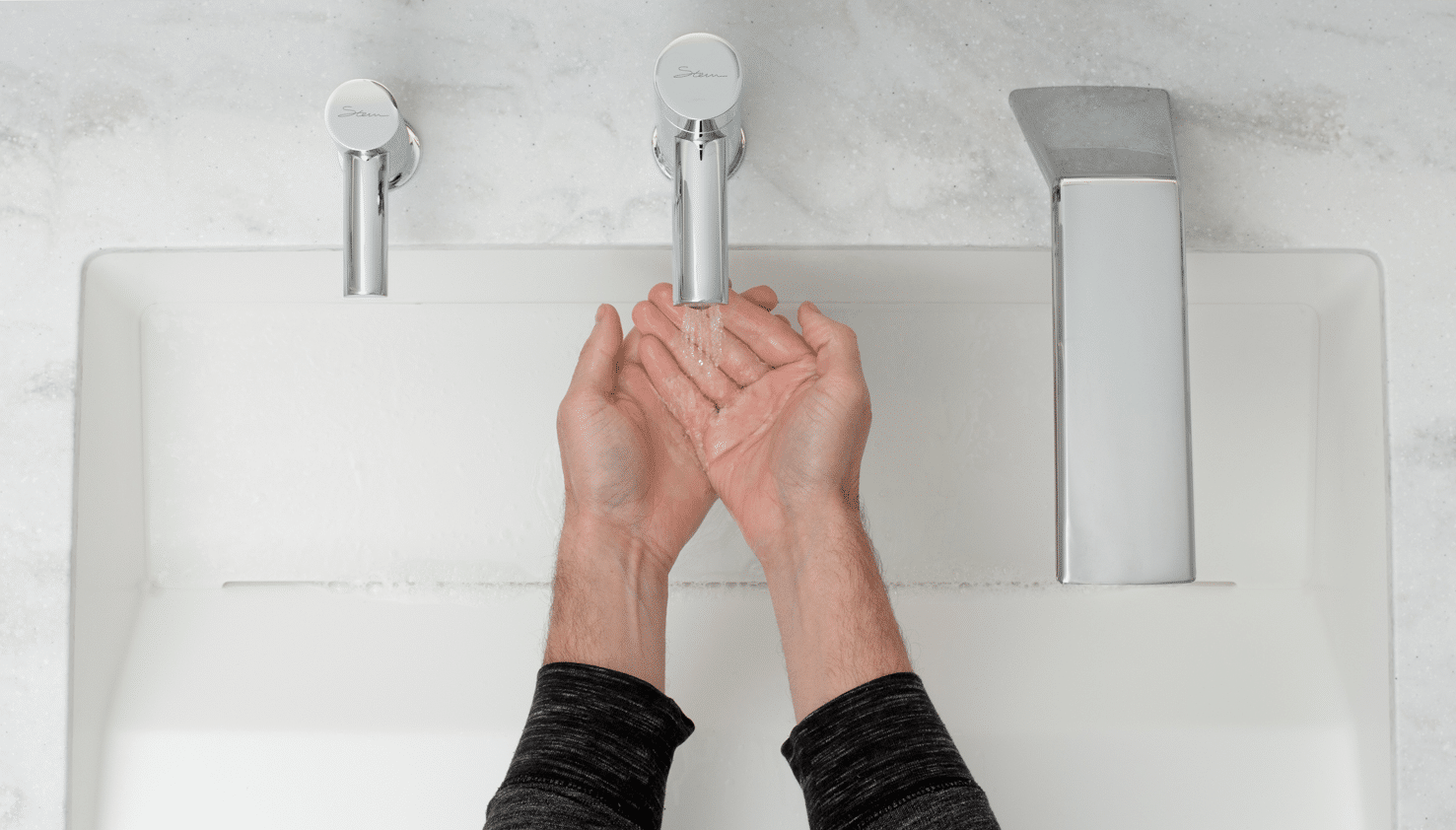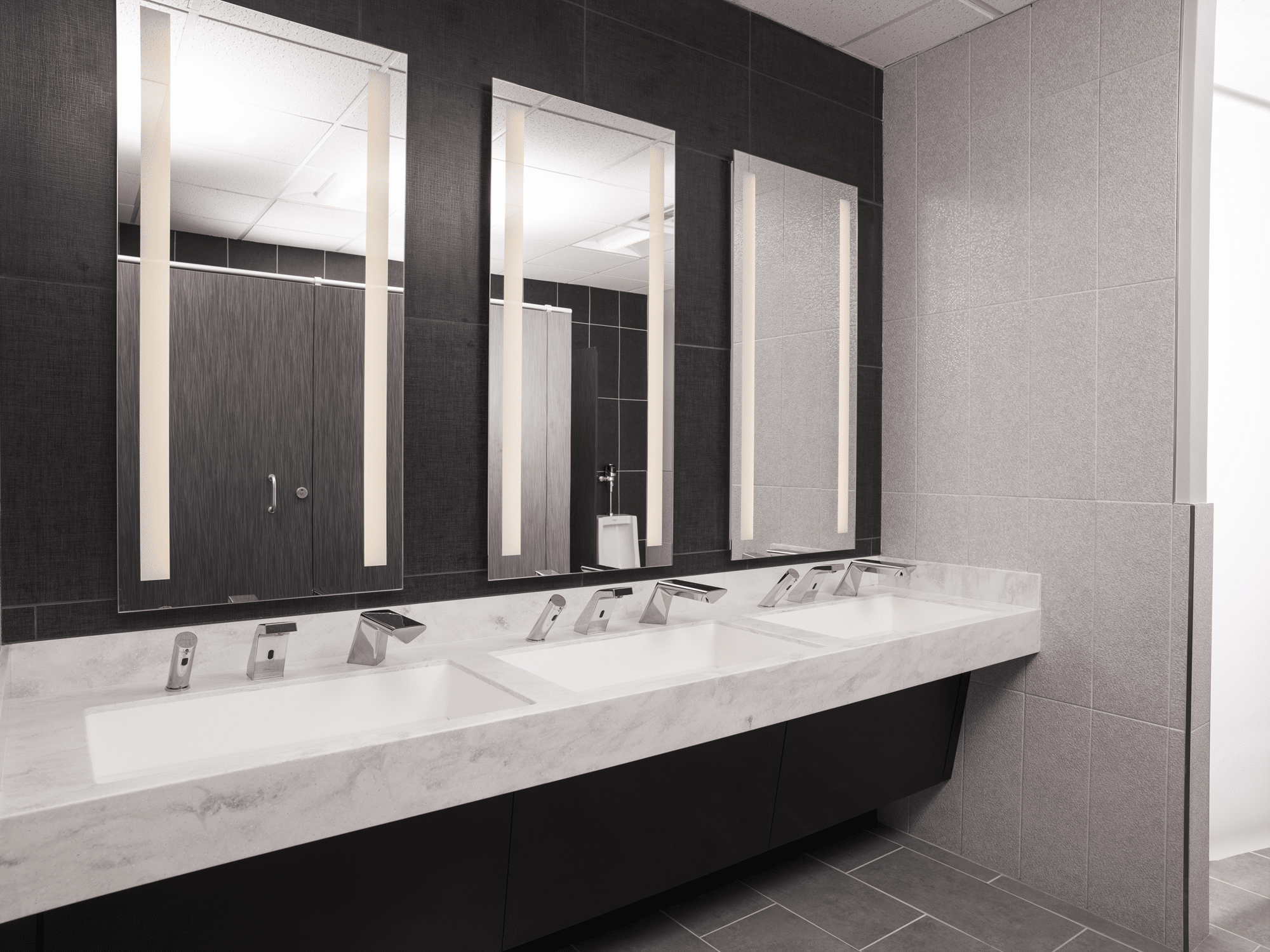
[Photo: Courtesy of Excel Dryer]
XLERATOR® Hand Dryers makes the move from the wall to the sink deck as part of a new, integrated sink system
There is near universal agreement that one should wash one’s hands after finishing up their other business in the bathroom: A 2016 survey showed that 92% of Americans think that’s the right thing to do. But the same surveys indicate the actual compliance rate is closer to 66%.
It’s a problem that has confounded public health officials as much as bathroom designers (not to mention restaurateurs). Motion-sensor activated soap and water, now fairly common in public restrooms, certainly make the process easy. High-velocity, energy-efficient hand dryers eliminate the mess and expense of paper towels. But the two-step process might have something to do with that non-compliant 34%.
Which is why William Gagnon of Excel Dryer has spent a good deal of time looking at, thinking, and tinkering with new ideas for the complete hand-washing process. The company’s XLERATOR® Hand Dryer already transformed the bathroom experience with the energy-efficient, high-speed dryers that are now in broad distribution; the product dries hands in 8 seconds using 80% less energy than conventional dryers, beating by far the carbon footprint of recycled paper towels.
As Gagnon explains, “People don’t have to dry their hands on their pants anymore.” Environmentalists cheer, too, as the XLERATOR helps builders achieve LEED and other sustainability certifications.

[Photo: Courtesy of Excel Dryer]
And yet, he knew there was room for improvement. In some settings, the sound from generating that rush of air can be problematic, as are the drops of water from hands onto the floor. And the wall-mounted dryers were something of a design challenge. If only soap, water, and drying air all could be at a single station.
And so, Excel Dryer sought to address this.
What they developed, in conjunction with the leading design firm Gensler and exclusively available through D|13 Group, is the XLERATORTM Sink System. It’s a three-fixture configuration that makes soap, water, and a fast dry all work together.
“The dryer is truly integrated with the sink and vice versa, not pieced together,” he says. In fact, he describes the design and the experience of its use as “agnostic, intuitive, and polite.” By that, he means the hand washer and the bathroom designer really don’t have to choose between one thing and another. The dryer is built into the hand-washing process by simply being step number three.
But adding a rush of heated air—moving at hundreds of miles per hour—to the sink isn’t as simple as one might expect. If the bowl is shaped the wrong way, that air could blow water back onto the user’s hands, arms, and even face. Part of the solution developed is best described as a gradient or sloped basin design, paired with a dryer fixture that reverses and fans out the airflow—directing water away from the user and into the sink, down the drain where it belongs.
The spacing between fixtures is optimized to prevent running the water and the dryer at the same time. Only when a hand or hands are directly under the dryer air outlet does it activate the dryer. An LED light guides the user to where optimal airflow will dry their hands fastest.

[Photo: Courtesy of Excel Dryer]
Sound challenges were tackled separately with a clever combination of engineering and acoustical science. The integrated design allows for an under mount of the dryer power system, which in and of itself reduces the noise. Sound is also muted by sound suppression foam mufflers in the air intake and outflow portions of the mechanism. But the magic comes from employment of Helmholtz resonators, which use sound waves tuned to the frequency of the undesirable sound, effectively canceling it out. The result is significantly reduced sound levels and overall improved sound quality, making the predominant sound in the restroom simply the rush of air.
In other words, this hand dryer is polite.
Excel Dryer’s wall-mounted XLERATOR underwent a full lifecycle assessment (LCA) in 2009 that looks at materials production, manufacturing, transportation, use, and end-of-life components of the dryer system. Even in the worst-case scenario, where the source of electricity is from a coal-burning electric utility, the XLERATOR makes a 27% lower contribution to greenhouse gases than recycled paper towels. On a per-use basis, it uses about 10% of the energy required to produce, transport, and dispose of paper towels. The XLERATOR Sink System has not yet undergone an LCA, but Gagnon expects the use of similar technologies will yield similar, pro-environmental results.
Fully customizable, the system can complement most any décor and can efficiently—and hygienically—accommodate high-traffic restrooms; the XLERATOR Sink System is already in use at several major venues, including casinos, offices, a health club, and restaurants.
Will more Americans—employees, customers, children as well as adults—be as polite as the sound of this iteration of the XLERATOR dryer by washing their hands more often? If the design proves to be a motivator, it’s hard to imagine how they could resist.
Learn more about Excel Dryer.
